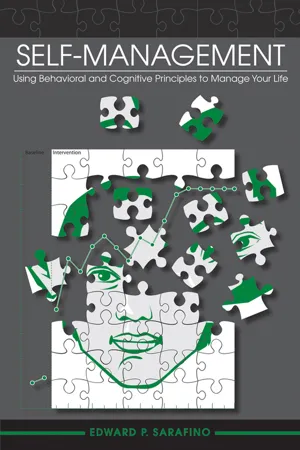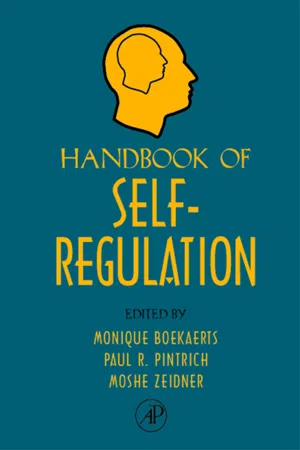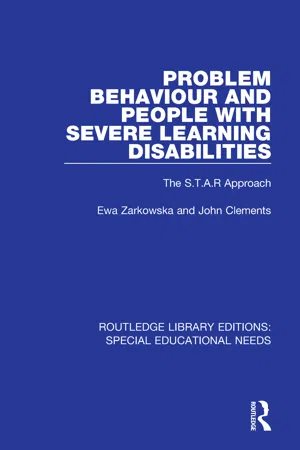Psychology
Self-Management Psychology
Self-management psychology refers to the practice of individuals taking control of their own behavior, thoughts, and emotions to achieve personal goals and well-being. It involves strategies such as self-monitoring, goal setting, and self-reinforcement to modify behavior and improve psychological functioning. This approach emphasizes the individual's active role in shaping their own experiences and outcomes.
Written by Perlego with AI-assistance
Related key terms
1 of 5
11 Key excerpts on "Self-Management Psychology"
- eBook - ePub
The Social Emotional Classroom
A New Way to Nurture Students and Understand the Brain
- Anna-Lisa Mackey, Melissa Ragan(Authors)
- 2022(Publication Date)
- Jossey-Bass(Publisher)
CHAPTER 3 Self-ManagementWhat Is Self-Management?
Like most people, you probably think self-management is synonymous with self-control. And based on the responses of other educators, you wouldn't be alone in your thinking:“Self-management is having the self-control to make good decisions for oneself.”- Occupational Therapist, ages Birth–15“The ability to control one's behavior and emotions appropriately for different settings.”- K–8 ELL Specialist“Managing your feelings alone and around others.”- High School Principal“In a word: Resilience. People that are able to bounce back from adversity are able to meet goals.”- K–12 Teacher Leadership“Being able to react appropriately in a given moment.”- Elementary Teacher“The ability to regulate one's emotional and physical state.”- High School TeacherAs with self-awareness, although these responses aren't wrong, self-management is about so much more than just self-control. CASEL identifies self-management as the ability to “manage one's emotions, thoughts, and behaviors effectively in different situations and to achieve goals and aspirations.”Some questions one might ask when trying to build self-management are:- What strategies do you use to manage your emotions?
- What stress management strategies are most effective for you?
- How do you model self-discipline?
- How do you demonstrate self-motivation?
- How do you set and achieve goals?
- What planning and organizational skills are most helpful?
- Are you able to take initiative and ask for help?
- What causes or inspires you to act?
What Does Current Research Say?
If the research on self-awareness seemed challenging, the good news is that the constructionist view of self-management seems much more straightforward. You might remember that the body is sending information to the brain all the time (interoception) and based on that information, the situation/context and your concepts, the brain makes predictions. Sometimes the predictions are instances of emotions. - eBook - PDF
Self-Management
Using Behavioral and Cognitive Principles to Manage Your Life
- Edward P. Sarafino(Author)
- 2012(Publication Date)
- Wiley(Publisher)
Individuals who can control their behavior have the skills to do so. These skills use established principles of behavior change to help people gain control over the conditions in their environment that encourage undesirable behaviors or discourage desirable ones. Applying principles of behavior change to modify one’s own behavior is called self-management or self-modification (Malott, 2005). Research comparing people who succeed at changing their behavior with people who don’t has shown that those who succeed apply more of these skills and use them longer (Heffernan & Richards, 1981; O’Neill, Sandgren, McCaul, & Glasgow, 1987; Perri & Richards, 1977). These findings indicate that the skills work. In general, people who fail at changing their behavior usually don’t have the skills to help them succeed or don’t use the ones they know. BENEFITS OF SELF-MANAGEMENT Being able to modify our own behavior offers many benefits, making us better able to achieve goals we set for ourselves and to enhance our psychological adjustment. Professionals—especially in the fields of psychology, counseling, social work, and health promotion—know these benefits and often teach self-management skills to their clients. If you plan to pursue a career in one of these fields, learning self-management techniques will be particularly useful. Self-management methods can help this man to curb his overeating and improve his nutrition. (Photo by Thinkstockphotos/Getty Images.) Chapter 1 / What Is Self-Management? 5 CHOOSING AND ACHIEVING GOALS Each of us can identify features of ourselves or our life circumstances that we would like to change. Sometimes these features are specific behaviors we don’t like, and sometimes the features are the outcomes of our current behavior, such as having low academic grades, being overweight, or having problems in social relationships. - eBook - ePub
Doing Better
Improving Clinical Skills and Professional Competence
- Jeffrey Kottler, W. Paul Jones, Jeffrey Kottler, W. Paul Jones(Authors)
- 2004(Publication Date)
- Routledge(Publisher)
High achievement in athletics is impossible without the development of self-regulation skills and the commitment to self-selected long-term goals. Self-regulation can be understood as the process during the performance of a cognitive task that allows individuals to control or direct their own activity through self-imposed rules or regulations in order to tailor performance to circumstances or surroundings (Ferrari, Pinard, Reid, & Bouffard-Bouchard, 1991). In the same way that successful athletes utilize a variety of cognitive skills to calculate efficient and effective sport behavior, successful therapists utilize selfsupervision skills to monitor their reactions and create effective interventions for clients. The concept of self-supervision has been recognized as an important skill in helping a therapist learn to be selfsufficient as a more effective professional (Todd, 1997). It is our belief that therapists looking to improve their self-supervision skills could benefit from the ideas about self-regulation taken from the discipline of sport psychology. The skills and theories that assist athletes’ adherence to self-regulation may help therapists develop strategies to promote selfsupervision in the practice of therapy. In this chapter we hope to highlight the links that tie these two concepts together. This chapter contains four sections. The first section examines some of the parallels between sports and therapy. The second section examines theories related to self-regulation in sport psychology. The third section reviews research examining the effectiveness of self-regulation training and the relationship between self-regulation and environmental factors. The final section focuses on the application of strategies and theories developed to promote peak performance in sport participation to the practice of self-supervision. For the most part, this chapter explores how the concept of self-regulation relates to the practice of therapeutic self-supervision. When links between the two concepts exist, we use examples to explore parallel experiences. - eBook - PDF
- Monique Boekaerts, Moshe Zeidner, Paul R Pintrich(Authors)
- 1999(Publication Date)
- Academic Press(Publisher)
In particular, the concept of self-regulation needs to be more sharply differentiated from related constructs in the same semantic domain (self- control, self-management, coping, adjustment, etc.). As pointed out by Creer, a myriad of terms (self-control, self-change, self-directed behavior) have proliferated recently to further muddy the water. A number of contributors to this volume (e.g., De Corte, Verschaffel, and Op 't Eynde, Matthews et al., and Brownlee et al.) point out that major constructs that relate to self-regulation (metacognition, volition, planning) overlap each other and also overlap related domains (e.g., transactional theories of personality and stress; Matthews et al.). We now briefly highlight a number 7~2 PART III. INTERVENTIONS AND APPLICATIONS OF SELF-REGULATION of overlaps among concepts in the self-regulation literature that are in need of further clarification. To begin with, the distinction between the two grand concepts of self-regulation and self-management is rather fuzzy. Self-regulation is some- times taken to imply that people follow self-set goals, whereas self- management is taken to imply that people follow goals set by others. However, as noted by Creer, there appears to be no clear demarcation among the terms, and the preceding distinction is not universally accepted. There is also some confusion regarding the concepts of regulation and self-regulation. Brownlee et al. propose that to distinguish between the two constructs, we need to know whether the goal originated in the external world or internal world (i.e., the social environment versus the self system), and whether the person sees its origin as being internal or external. Thus, when a person is setting a goal or defining a relevant procedure, he or she is self-regulating; otherwise, his or her behavior is being externally or other regulated. - Debbie Kralik, Barbara Paterson, Vivien Coates, Debbie Kralik, Barbara Paterson, Vivien Coates(Authors)
- 2016(Publication Date)
- Wiley-Blackwell(Publisher)
chronic condition self-management (‘self-management’) has emerged as a concept to describe the tasks, roles and responsibilities of individuals as they cope with their chronic conditions from diagnosis to their long-term management. This chapter will provide international, historical and policy contexts to self-management – describing associated concepts that overlap with or inform an understanding of self-management from both the person’s and the health professional’s perspective. It will also describe the development of self-management concepts and practical applications of these, including nationally accepted definitions of self-management in Australia.Background to the use of the term self-management
The individual’s perspective
There is little explicit recognition that being diagnosed with a chronic illness is a critical life event for the individual. Such a crisis has well-defined characteristics (Caplan 1964; Gunderson & Rahe 1974). Put simply, it is a time of emotional disequilibrium and one that needs resolution through the learning of new skills to cope with the challenge that is presented. Once the challenge is confronted, dealt with and overcome, the person achieves a sense of mastery, and self-efficacy grows (Bandura 1977). This is the first step in developing an effective self-management approach to any clinical condition.The person’s experience of chronic illness is subjective, interpersonal and social. Self-management tasks involve an understanding of and distinguishing between the illness experiences, levels of distress, perceived loss of well-being, illness behaviour and the impaired functioning observed by others. Optimal self-management has the potential to also reduce the effects of the conditions or diseases on the person, such as social stigma and exclusion, and increase levels of participation in the family and community. Self-management tasks promote full personal and social well-being. Likewise, the carer’s perspective is unique. It involves the impact that caring for someone with chronic illness has on the carer’s role, interpersonal relationships with the person and others as well as their own careers and lives (Australian Bureau of Statistics 2003).- eBook - ePub
Problem Behaviour and People with Severe Learning Disabilities
The S.T.A.R Approach
- Ewa Zarkowska, John Clements(Authors)
- 2018(Publication Date)
- Taylor & Francis(Publisher)
For the person with learning difficulties who is the recipient of external control programmes there are other difficulties. It may lead the individual to view himself as incapable of independent action, thus increasing his sense of dependency and blocking this area of personal development. It may create frustration if he has developed personal decision-making skills but is not given the opportunity to use them. Frustration may contribute to the further creation of behaviour deemed to be inappropriate. Finally, it may influence how others view him, seeing him as by nature unable to take responsibility for his own actions.There are, therefore, many good reasons for involving people with learning difficulties in the management of their own behaviour, for helping them to take greater responsibility for their actions and for reducing reliance upon external methods of behavioural change and control - in other words, for teaching and encouraging self-management.Figure 9.1 Encouraging self-management.Self-Management - General Principles
Defining Self-Management
Self-management describes the situation where some of the key factors which influence how an individual behaves come from within the person or are in some other way under the direct control of the individual. The word ‘some’ is a reminder that self-and external control are not contradictory ideas. The influences over human behaviour in any situation are many and varied and may include factors over which the individual has direct control and those over which he has no control. The precise balance of external and internal control factors will depend upon both the situation and the level of development that the individual has reached. In general terms, two broad categories of self-management can be identified - self-direction of behaviour and independent problem solving.Self-direction of behaviour
Self-direction of behaviour occurs when the individual implements specific procedures to ensure that certain specific behaviour occurs. He can structure settings (for example, arrange a time and place for studying which is likely to be distraction-free). He can manipulate cues which increase or decrease the likelihood of performing certain actions (for example, write out a time-table for what is to be studied). He can provide direct triggers for the starting and stopping of his behaviour (for example, set an alarm clock to signal the start of a study period, then reset it to signal the end of the study period). He can provide reinforcing results for desirable actions (for example, a refreshment break following completion of a time-tabled piece of study). He can monitor and evaluate his progress (for example, chart the proportion of study assignments completed in relation to the number planned). In this way the individual takes active steps to ensure that certain of his own behaviour occurs. - eBook - ePub
Leadership Development
Paths To Self-insight and Professional Growth
- Manuel London(Author)
- 2001(Publication Date)
- Psychology Press(Publisher)
3 Self-Regulation: Processes for Maintaining Motivation and Resilience
DOI: 10.4324/9781410604514-3One important facet of gaining self-insight is being able to incorporate new information about themselves and make changes in their behavior and performance. Leaders need to be able to regulate their behavior effectively and respond appropriately in different situations and under different conditions. They need to understand their capabilities in relation to the changing demands of the business. As they get feedback about what is and is not working, they may need to alter their views of themselves. This requires recognizing that the information disconfirms what they already thought about themselves (an uncomfortable position to be in) and then using the information to revise their self-concept and change their behavior. This is the process of self-regulation. Self-regulation allows people to maintain their motivation and have the resilience they need to overcome barriers to goal accomplishment.This chapter examines how leaders and people, in general, regulate their behavior. The chapter considers conditions that foster self-regulation and what happens when leaders fail to regulate their actions and change their self-concepts. The discussion begins with a general explanation of self-regulation.The Meaning and Value of Self-Regulation
Self-regulation, or self-control, is any effort to alter one’s own responses, whether these responses are thoughts, actions, feelings, desires, or performances (Baumeister, Heatherton, & Tice, 1994 ). Without self-regulation, peopie would respond to a situation on the basis of merely habit, inclination, or innate tendencies. Self-regulation prevents this natural response and substitutes another, or there may be a lack of response altogether.Self-regulation involves a hierarchy of processes. Lower processes are immediate reactions that are generally gratifying. Higher order processes entail longer time spans, such as postponing or foregoing gratification. When giving in to instant or rapid gratification overrides a resolution to abstain, the individual has failed in self-regulation. This implies a competition between responses. Higher processes suggest standards individuals would like to attain. However, this requires the strength to overcome natural tendencies and achieve a higher order response, which may be equally or more rewarding, but the rewards may be longer in coming. Not succumbing to natural or habitual tendencies requires strength (or willpower). It also requires a supportive environment. Few people can resist a rich chocolate cake if it is shoved in front of them for desert or is readily available every time they open the refrigerator door. However, if the environment limits temptation and provides support for control (the Weight Watcher’s concept), then people are more able to resist. - eBook - ePub
Self-Regulated Learning and Academic Achievement
Theoretical Perspectives
- Barry J. Zimmerman, Dale H. Schunk, Barry J. Zimmerman, Dale H. Schunk(Authors)
- 2013(Publication Date)
- Routledge(Publisher)
planning and strategy selection, students have the opportunity to put themselves in action, to make personal plans, and to select the appropriate strategies for accomplishing learning goals expressive of their more general self-development and self-determination goals. In specific learning situations, the personally meaningful and relevant goals students selected for mastery, accomplishment, or growth in knowledge and skills have the purpose of forming and directing the kind and nature of planning activities and strategies selected. At this step, it is critical that students have developed the level of metacognitive knowledge (including self-knowledge) and processes (including self-monitoring, self-reflection, and self-evaluation) for engaging in effective planning and strategy selection.The final step of self-regulation, performance execution and evaluation, further requires the development of self-monitoring, self-reflection, and self-evaluation processes. To put the self in action, students need to direct and maintain their attention appropriately, evaluate their progress relative to desired goals, regulate and control their affect, and execute the actions necessary for reducing the performance discrepancies between actual and desired goals. Again, the development of self-awareness, self-monitoring, and self-evaluation processes is critical to effective performance execution and evaluation in a self-directed and self-regulated sense. For students lacking in self-knowledge and self-regulation processes, interventions help to enhance or supplant existing self-values, capacities, and skills.Practices That Enhance Self-Regulated Learning by Focusing on Understanding of Inherent Capacities for Motivation and Learning
Another approach to the development of self-regulated behavior is that developed by Mills (1995). This approach suggested that self-regulation is the natural response to learners’ understanding of their inherent capacities for motivation and learning—combined with their understanding of the role of their thinking in feelings and motivation as well as their agency in choosing what to think on a moment-to-moment basis. From this perspective, the interventions most needed are those that educate - eBook - ePub
- Haukur Ingi Jonasson, Helgi Thor Ingason(Authors)
- 2018(Publication Date)
- Routledge(Publisher)
3 Self-management for leadershipThe previous chapter looked at the role of personal strategic planning and journal writing in furthering your leadership skills. The idea was for you to get to know yourself, identify your ambitions, figure out your strengths, weaknesses, threats, and opportunities and then determine the way forward. When undertaking such self-examination, it is likely that you will discover various aspects in your way of thinking, your attitude or behaviour that you would like to change or influence. This chapter discusses how you can work with the skills, strengths, and weaknesses of which you are aware and how to get started identifying areas for improvement. This isn’t simply a matter of pointing out the myriad of methods available. Rather, our primary goal is to draw attention to the nature of your self-awareness in the context of behavioural and cognitive modifications . This is the realm of positive psychology, cognitive-behavioural psychology, and coaching, all of which focus on helping people to live better by using their conscious mind to exchange their bad habits for better habits. This chapter, therefore, discusses conscious tendencies and working with self-awareness, while the next chapter looks at unconscious tendencies and working with the unconscious mind.Habits and cognitive behaviourOne vital leadership competence is to organise your work in accordance with the situation and available resources. Situations can differ and that demands personal agility. You need to both comprehend the situation you are dealing with and self-manage accordingly. In order to do so, insights from positive psychology, cognitive-behavioural psychology, and coaching come in handy.Psychologist William James, who is sometimes called the father of American psychology, once said that when living beings are observed from the outside they appear to be little more than a collection of habits. He reached the conclusion, which has subsequently been thoroughly verified by cognitive neuropsychology, that the central nervous system works by nerve cells signalling one another and forming circuits or neural pathways. The repeated activity of particular neural pathways then creates tendencies that become habits. James believed that although the habits of animals were involuntary, humans were able to moderate and control them and he realised that self-control involves altering your response to habits: instead of being the puppet of your unconscious tendencies, you should be pulling some of the strings yourself in the development of the conscious mind. - Sherry Cormier, Paula Nurius, Cynthia Osborn, , Sherry Cormier, Paula Nurius, Cynthia Osborn(Authors)
- 2016(Publication Date)
- Cengage Learning EMEA(Publisher)
Cengage Learning reserves the right to remove additional content at any time if subsequent rights restrictions require it. Self-Management Strategies 555 b. Focus on the process of change—focusing on a skills de-velopment attitude rather than the final outcome—and practice, practice, practice. c. Distinguish the present from the past, actively relegat-ing past discouraging or failure outcomes to the past, monitoring present progress, and attending to small, incremental improvements. Whether by dent of personality or past experience, there is huge variability in how people perform—for ex-ample, what they are willing to attempt, how long they will persist, and how varied their mastery efforts will be. At one extreme are people who are motivated, energized, and risk-taking despite the possibility of failure—partly because they do not anticipate failure, are able to interpret failure in ways that do not significantly diminish their future self-efficacy expectations, and persist more vigor-ously. At the other extreme are people who are character-ized by depressive feelings that contribute to pessimism, a low level of energy, and negative internal dialogue, result-ing in low levels of attempted performance and greater inclination to interpret failure as further evidence that they are not capable (“This is just another example that I can never do anything right”), thus deepening future low-efficacy expectations. Most of us fall somewhere between these two extremes. And, as previously noted, we can see ourselves and be-have quite efficaciously in some life domains but struggle greatly in others. In fact, evidence indicates that we can have varying degrees of perceived self-efficacy in different aspects of a single domain. This has implications for as-sessment and intervention.- eBook - PDF
- Sanna Jarvela(Author)
- 2011(Publication Date)
- Elsevier(Publisher)
In Baumeister, R. F. and Vohs, K. D. (eds.) Handbook of Self-Regulation: Research, Theory, and Applications , pp 99–129. Guilford Press, New York. Oyserman, D., Bybee, D., Terry, K., and Hart-Johnson, T. (2004). Possible selves as roadmaps. Journal of Research in Personality 38 (2), 130–149. Weinstein, C. E. and Hume, L. M. (1998). Study Strategies for Lifelong Learning. Washington, DC: American Psychological Association. Zimmerman, B. J., Bonner, S., and Kovach, R. (1996). Developing Self-Regulated Learners: Beyond Achievement to Self-Efficacy. Washington, DC: American Psychological Association. Zimmerman, B. and Schunk, D. (2007). Motivation and Self-Regulated Learning: Theory, Research, and Applications. Boca Raton, FL: Taylor and Francis. Relevant Websites http://psychclassics.yorku.ca – Classics in the History of Psychology: What is an emotion? http://www.ericdigests.org – ERICDigest.org: Self-Regulation through Goal Setting. 216 Self-Regulatory Processes http://www.ncrel.org – Northcentral Regional Education Laboratory: 21st Century Skills: Self Direction. http://www.nwrel.org – Northwest Regional Educational Laboratory: Developing Self Directed Learners. http://content.scholastic.com: Scholastic: Developing Self-Regulation. http://www.psych.rochester.edu – Self Determination Theory Self Regulation (Theory and Questionnaires). http://plato.stanford.edu – Stanford Encyclopedia of Philosophy: Personal Autonomy. http://www.sitemaker.umich.edu– UM.SiteMaker: Culture and the Self Research Laboratory. http://www.yale.edu – Yale University: Yale–New Haven Teachers Institute Unit by Elisabeth Johnson. Volitional Control of Learning 217 Motivation Regulation C A Wolters, University of Houston, Houston, TX, USA S A Mueller, Pflugerville ISD, Austin, TX, USA ã 2010 Elsevier Ltd. All rights reserved. Introduction Students’ motivation within academic tasks is consistently viewed as a critical determinant of their learning and achievement.
Index pages curate the most relevant extracts from our library of academic textbooks. They’ve been created using an in-house natural language model (NLM), each adding context and meaning to key research topics.










